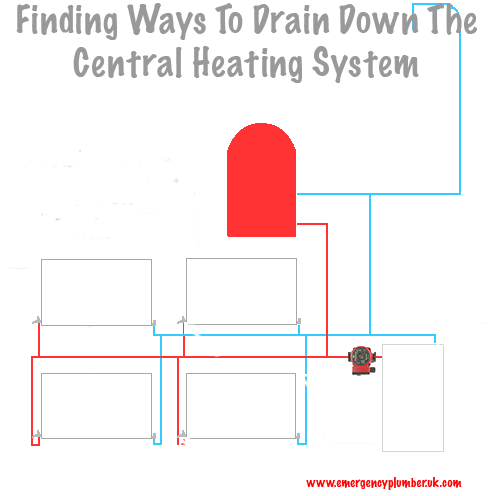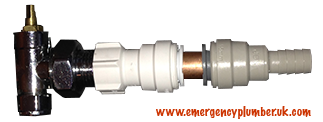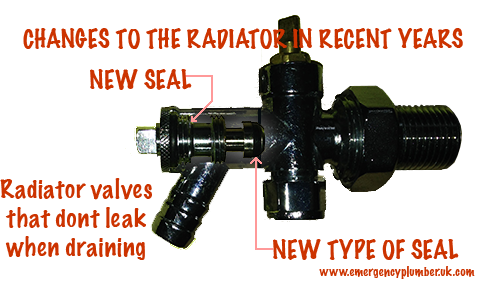Draining Central Heating System Problems & Cures
Welcome to the Information of Draining Central Heating System. In the Picture Diagram of draining down the central heating system, we have arrows pointing to drain off point of where you will find your typical drain off points. Just below are some typical questions before calling an emergency plumber.
18 Ways to drain down a central heating system

- What do I need to drain down the central heating?
- What to do before draining central heating system?
- Drain off not draining my central heating water?
- Where can I find the drain off points of the central heating system?
- I have no draining valves on my central heating, is there an alternative way to drain down?
- How long does it take to drain the central heating system?
- How best to drain the water in my radiators and pipes?
- Should there be a draining point for my radiators outside?
- Should there be a draining valve on my boiler?
- When draining a central heating system and refilling, should I use any chemicals?
- What is the difference in draining an open vented combination systems and an un-vented systems?
- Should there be a drain off valves on all radiators?
- Why does the drain valve leak water when draining down the central heating?
- How can I drain a radiator that has no drain off valve that is turned off?
- Is it good practice to drain a combination boiler via the pressure release valve?
- What ways should I not drain down a central heating system?
- Water coming out slowly from radiator valve of central heating, Why?
- After draining central heating system, how to avoid airlocks when refilling?
What do I need to drain down the central heating
draining central heating system, you will need a long enough hosepipe, bleed key, pair off grips and possibly a jubilee clip. Don’t forget to place a towel under the draining valve. For the more advanced draining of the central heating system, you will require the radiator key and either a draining valve or temporary, you could use a 15mm isolation valve and a bit of 15mm copper pipe. There are water proof sheets known as water blankets that you can buy from the BES site, the water blankets hold quite a lot of water, this may help under circumstance that it may get a bit messy.
What to do before draining central heating system
Before starting the process of draining central heating system and your wondering what to do. Firstly make sure that the water supply to the central heating system is in the off position. This can either be turned of at the mains water stopcock, the isolation to the central heating tank or the gate valve after the central heating tank. For a combination boiler, you do not require to turn any radiator valves off.
Drain off not draining my central heating water
If your drain off is not draining your central heating system and your wondering why, this will most likely be due to the age of the drain off valve and the muck that is stuck behind the draining valve. There is a very slight possibly that if you stick something thin down the valve, such as solder wire, you may get rid of the blockage once the valve is in the full open position. There are other possibilities as mentioned in the paragraph below.
Where can I find the drain off points of the central heating system
The drain off point for draining central heating system, will be found at either the lowest point of the plumbing pipes, almost the lowest point next to the radiators or if your very lucky, you may find it on the outside wall. If you only need to drain the upstair radiators, you can sometimes do this by a draining point next to the boiler.
I have no draining valves on my central heating, is there an alternative way to drain down
The alternative way to draining the central heating system is, if you have no draining point, fit a draining point to the top of the radiator. When both radiator valves are in the off position. Once the draining point is in place, then attach the hosepipe and open draining valve including both radiator valves. On some radiators you may not be-able to do this.  There are two other similar actions that can be taken. Turn both valves off and drain radiator by using a water proof mat, specialised for this type of job. Place a cut tub under the nut attached closest to the radiator and drain. You may need to open and close a few times, as this can be awkward and messy. Depending on the size of the radiator, you may need at least two bucket full of water. Once the radiator is empty, either turn the radiator valve or take radiator off the wall, but be very careful as the radiator water in the radiator can stain and is best if both sides were blanked off. Attach hose to valve and start draining central heating system. You may need a special fitting to attach to the valve (shown in the picture above) before attaching a hose, using a speed fit tap connector and speed fit draining fitting, this should do the trick. The second option for a long term solution is to freeze the pipework at both ends off the radiator and fit new radiator valve for a draining point solving any future issue as there most likely will be. Martin Smith would personally use the electric pipe freezing machine.
There are two other similar actions that can be taken. Turn both valves off and drain radiator by using a water proof mat, specialised for this type of job. Place a cut tub under the nut attached closest to the radiator and drain. You may need to open and close a few times, as this can be awkward and messy. Depending on the size of the radiator, you may need at least two bucket full of water. Once the radiator is empty, either turn the radiator valve or take radiator off the wall, but be very careful as the radiator water in the radiator can stain and is best if both sides were blanked off. Attach hose to valve and start draining central heating system. You may need a special fitting to attach to the valve (shown in the picture above) before attaching a hose, using a speed fit tap connector and speed fit draining fitting, this should do the trick. The second option for a long term solution is to freeze the pipework at both ends off the radiator and fit new radiator valve for a draining point solving any future issue as there most likely will be. Martin Smith would personally use the electric pipe freezing machine.
How long does it take to drain the central heating system
To drain the central heating system, it takes on average 20-minutes, however a more complicated system depending on the draining down process can take as much as 2-hours leaving the plumber very frustrated.
How best to drain the water in my radiators and pipes
The best way for draining central heating system is to have a drain off point to the outside of the house, saving any future difficulties. If it’s just the radiator you need to drain down, then there should be a drain off point to every radiator in the house.
Should there be a draining point for my radiators outside
There doesn’t have to be a draining point on the outside of the house however, we believe it should come as standard, saving time and effort in the future. Example: How many times would you have to drain the central heating in the lifetime of the central heating versus how long would it take to fit a drain off point.
Should there be a draining valve on my boiler
On every boiler we believe, there should be a draining valve, however this is not mandatory.
When draining a central heating system and refilling, should I use any chemicals
If draining the central heating, it is not mandatory to put chemicals in the system however, if you put chemical in the central heating system, then your pipework, valves and all other components, will last many longer years and therefor be worth while using. If an emergency plumber attends the property and the system has to be refilled, then this may not be necessary due to stock carried by the emergency plumber but, it is advised to use some at a later date.
What is the difference in draining an open vented combination systems and an un-vented systems
The difference between draining an open vented combination systems and an un-vented system is a question asked to me from another plumber and the answer is: the open vented system is a gravity pressure, where the un-vented is pressurised meaning in the un-vented system you do not need to turn the water off, when draining central heating system.
Should there be a drain off valves on all radiators
Due to cost cutting, there is no requirements to having a drain off valve on the radiators but, like in the paragraph above, I mentioned it is best to fit drain off points on every radiator.
Why does the drain valve leak water when draining down the central heating system

The drain off valve leaks when draining down due to there being no washer or the washer is worn but, most likely due to no washer as the old valve tend not to have one. As shown in the picture here is the new type of drain off valve, when opening the valve the washer as above about 8mm opening capacity to allow enough water flow to drain out.
How can I drain a radiator that has no drain off valve that is turned off
To drain a radiator, as mentioned in one off the above paragraphs, you can either freeze the pipes at both ends and fit a drain off valve to drain down or just open a nut nearest to the radiator at both end and drain down. To drain slowly, you may need to keep the bleed valve in the closed position. To drain the radiator quickly, you will need to undo the bleed valve. It is very important to have a tub with cut outs or not cut out, under the radiator. There are special bags you can buy to drain the complete radiator system without worrying of getting any water on the floor. Another tip would be to hoover the water as it is draining using a wet and dry vacuum cleaner.
Is it good practice to drain a combination boiler via the pressure release valve
You could drain the central heating water by opening up the pressure release valve however, it is not good practice to drain through the pressure release valve due to a low risk factor of the pressure release valve going faulty and not working correctly.
What ways should I not drain down a central heating system
You should not drain the central heating system by opening up the pressure release valve due to the low risks. You should not play around with a faulty drain off valve well live due to a sudden rush of water with no preparations and flooding.
Water coming out slowly from radiator valve of central heating, Why
The reason central heating water will come out slowly of the drain off valve is most likely because the drain off valve may be full of muck. Other reasons are because, on most radiator valves of today, the type of washer used to shut off, has a hole and when undoing the valve, the washer gets stuck and the central heating water uses the central hole of the washer for water to drain.
After draining central heating system, how to avoid airlocks when refilling
When draining central heating system, it is very important that you drain as many radiators as possible or you could be open to an airlock. It is very important to keep all the radiator valves in the open position to ensure there is no water left behind when draining, allowing air pockets to form.
Other useful information about draining central heating system
If you require an emergency plumber, then please give us a call on the above number, so that we can recommend you a self employed plumber anywhere in the UK as long as we don’t need to catch a boat to get over to you. If your a plumber and would like to get on to our recommendation list, then please send us an email to emergencyplumber@me.com

